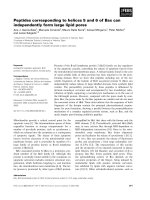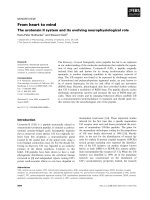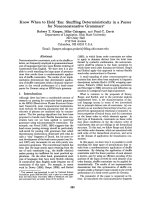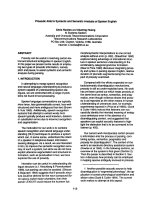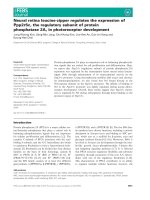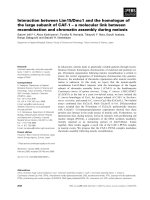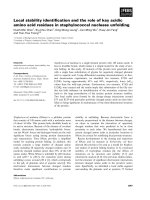Báo cáo khoa học: "From RAGS to RICHES: exploiting the potential of a flexible generation architecture" pot
Bạn đang xem bản rút gọn của tài liệu. Xem và tải ngay bản đầy đủ của tài liệu tại đây (125.93 KB, 8 trang )
From RAGS to RICHES: exploiting the potential of a flexible generation
architecture
Lynne Cahill , John Carroll , Roger Evans , Daniel Paiva ,
Richard Power , Donia Scott and Kees van Deemter
ITRI, University of Brighton
Brighton, BN2 4GJ, UK
School of Cognitive and Computing Sciences, University of Sussex
Brighton, BN1 9QH, UK
Abstract
The RAGS proposals for generic speci-
fication of NLG systems includes a de-
tailed account of data representation,
but only an outline view of processing
aspects. In this paper we introduce a
modular processing architecture with a
concrete implementation which aims to
meet the RAGS goals of transparency
and reusability. We illustrate the model
with the RICHESsystem – a generation
system built from simple linguistically-
motivated modules.
1 Introduction
As part of the RAGS (Reference Architecture for
Generation Systems) project, Mellish et al (2000)
introduces a framework for the representation of
data in NLG systems, the RAGS ‘data model’.
This model offers a formally well-defined declar-
ative representation language, which supports the
complex and dynamic data requirements of gen-
eration systems, e.g. different levels of repre-
sentation (conceptual to syntax), mixed represen-
tations that cut across levels, partial and shared
structures and ‘canned’ representations. However
We would like to acknowledge the financial support of
the EPSRC (RAGS – Reference Architecture for Generation
Systems: grant GR/L77102 to Donia Scott), as well as the
intellectual contribution of our partners at Edinburgh (Chris
Mellish and Mike Reape: grant GR/L77041 to Mellish) and
other colleagues at the ITRI, especially Nedjet Bouayad-
Agha. We would also like to acknowledge the contribution
of colleagues who worked on the RICHES system previ-
ously: Neil Tipper and Rodger Kibble. We are grateful to
our anonymous referees for their helpful comments.
RAGS, as described in that paper, says very little
about the functional structure of an NLG system,
or the issues arising from more complex process-
ing regimes (see for example Robin (1994), Inuie
et al., (1992) for further discussion).
NLG systems, especially end-to-end, applied
NLG systems, have many functionalities in com-
mon. Reiter (1994) proposed an analysis of such
systems in terms of a simple three stage pipeline.
More recently Cahill et al (1999) attempted to re-
peat the analysis, but found that while most sys-
tems did implement a pipeline, they did not im-
plement the same pipeline – different functional-
ities occurred in different ways and different or-
ders in different systems. But this survey did
identify a number of core functionalities which
seem to occur during the execution of most sys-
tems. In order to accommodate this result, a ‘pro-
cess model’ was sketched which aimed to support
both pipelines and more complex control regimes
in a flexible but structured way (see (Cahill et al.,
1999),(RAGS, 2000)). In this paper, we describe
our attempts to test these ideas in a simple NLG
application that is based on a concrete realisation
of such an architecture
1
.
The RAGS data model aims to promote com-
parability and re-usability in the NLG research
community, as well as insight into the organisa-
tion and processing of linguistic data in NLG. The
present work has similar goals for the processing
aspects: to propose a general approach to organis-
ing whole NLG systems in a way which promotes
1
More details about the RAGS project, the
RICHES implementation and the OASYS subsys-
tem can be found at the RAGS project web site:
/>the same ideals. In addition, we aim to test the
claims that the RAGS data model approach sup-
ports the flexible processing of information in an
NLG setting.
2 The RAGS data model
The starting point for our work here is the RAGS
data model as presented in Mellish et al (2000).
This model distinguishes the following five levels
of data representation that underpin the genera-
tion process:
Rhetorical representations (RhetReps) define how propo-
sitions within a text are related. For example, the sen-
tence “Blow your nose, so that it is clear” can be con-
sidered to consist of two propositions: BLOW YOUR
NOSE and YOUR NOSE IS CLEAR, connected by a re-
lation like MOTIVATION.
Document representations (DocReps) encode information
about the physical layout of a document, such as tex-
tual level (paragraph, orthographic sentence, etc.),
layout (indentation, bullet lists etc.) and their relative
positions.
Semantic representations (SemReps) specify information
about the meaning of individual propositions. For
each proposition, this includes the predicate and its
arguments, as well as links to underlying domain ob-
jects and scoping information.
Syntactic representations (SynReps) define “abstract”
syntactic information such as lexical features (FORM,
ROOT etc.) and syntactic arguments and adjuncts
(SUBJECT, OBJECT etc.).
Quote representations These are used to represent literal
unanalysed content used by a generator, such as
canned text, pictures or tables.
The representations aim to cover the core com-
mon requirements of NLG systems, while avoid-
ing over-commitment on less clearly agreed is-
sues relating to conceptual representation on the
one hand and concrete syntax and document ren-
dering on the other. When one considers process-
ing aspects, however, the picture tends to be a lot
less tidy: typical modules in real NLG systems
often manipulate data at several levels at once,
building structures incrementally, and often work-
ing with ‘mixed’ structures, which include infor-
mation from more than one level. Furthermore
this characteristic remains even when one consid-
ers more purely functionally-motivated ‘abstract’
NLG modules. For example, Referring Expres-
sion Generation, commonly viewed as a single
task, needs to have access to at least rhetorical and
document information as well as referencing and
adding to the syntactic information.
To accommodate this, the RAGS data model in-
cludes a more concrete representational proposal,
called the ‘whiteboard’ (Calder et al., 1999), in
which all the data levels can be represented in
a common framework consisting of networks of
typed ‘objects’ connected by typed ‘arrows’. This
lingua franca allows NLG modules to manipulate
data flexibly and consistently. It also facilitates
modular design of NLG systems, and reusability
of modules and data sets. However, it does not in
itself say anything about how modules in such a
system might interact.
This paper describes a concrete realisation of
the RAGS object and arrows model, OASYS,
as applied to a simple but flexible NLG system
called RICHES. This is not the first such re-
alisation: Cahill et al., (2000) describes a par-
tial re-implementation of the ‘Caption Generation
System’ (Mittal et al., 1999) which includes an
objects and arrows ‘whiteboard’. The OASYS
system includes more specific proposals for pro-
cessing and inter-module communication, and
RICHES demonstrates how this can be used to
support a modular architecture based on small
scale functionally-motivated units.
3 OASYS
OASYS (Objects and Arrows SYStem) is a soft-
ware library which provides:
an implementation of the RAGS Object and
Arrows (O/A) data representation,
support for representing the five-layer RAGS
data model in O/A terms,
an event-driven active database server for
O/A representations.
Together these components provide a central core
for RAGS-style NLG applications, allowing sepa-
rate parts of NLG functionality to be specified in
independent modules, which communicate exclu-
sively via the OASYS server.
The O/A data representation is a simple
typed network representation language. An O/A
database consists of a collection of objects, each
of which has a unique identifier and a type, and
arrows, each of which has a unique identifier,
a type, and source and target objects. Such a
database can be viewed as a (possibly discon-
nected) directed network representation: the fig-
ures in section 5 give examples of such networks.
OASYS pre-defines object and arrow types re-
quired to support the RAGS data model. Two ar-
row types, el (element) and el(<integer>),
are used to build up basic network structures –
el identifies its target as a member of the set rep-
resented by its source, el(3), identifies its tar-
get as the third element of the tuple represented
by its source. Arrow type realised by re-
lates structures at different levels of representa-
tion. for example, indicating that this SemRep
object is realised by this SynRep object. Arrow
type revised to provides for support for non-
destructive modification of a structure, mapping
from an object to another of the same type that
can be viewed as a revision of it. Arrow type
refers
to allows an object at one level to indi-
rectly refer to an object at a different level. Object
types correspond to the types of the RAGS data
model, and are either atomic, tuples, sets or se-
quences. For example, document structures are
built out of DocRep (a 2-tuple), DocAttr (a set
of DocFeatAtoms – feature-value pairs), DocRe-
pSeq (a sequence of DocReps or DocLeafs) and
DocLeafs.
The active database server supports multiple
independent O/A databases. Individual modules
of an application publish and retrieve objects and
arrows on databases, incrementally building the
‘higher level’, data structures. Modules com-
municate by accessing a shared database. Flow
of control in the application is event-based: the
OASYS module has the central thread of execu-
tion, calls to OASYS generate ‘events’, and mod-
ules are implemented as event handlers. A mod-
ule registers interest in particular kinds of events,
and when those events occur, the module’s hander
is called to deal with them, which typically will
involve inspecting the database and adding more
structure (which generates further events).
OASYS supports three kinds of events: pub-
lish events occur whenever an object or arrow is
published in a database, module lifecycle events
occur whenever a new module starts up or termi-
nates, and synthetic events – arbitrary messages
passed between the modules, but not interpreted
by OASYS itself – may be generated by mod-
ules at any time. An application starts up by ini-
tialising all its modules. This generates initialise
events, which at least one module must respond
to, generating further events which other modules
may respond to, and so on, until no new events
are generated, at which point OASYS generates
finalise events for all the modules and terminates
them.
This framework supports a wide range of archi-
tectural possibilities. Publish events can be used
to make a module wake up whenever data of a
particular sort becomes available for processing.
Lifecycle events provide, among other things, an
easy way to do pipelining: the second module in a
pipeline waits for the finalise event of the first and
then starts processing, the third waits similarly
for the second to finalise etc. Synthetic events
allow modules to tell each other more explicitly
that some data is ready for processing, in situa-
tion where simple publication of an object is not
enough.
RICHES includes examples of all three
regimes: the first three modules are pipelined us-
ing lifecycle events; LC and RE, FLO and REND
interact using synthetic events; while SF watches
the database specifically for publication events.
4 RICHES
The RICHES system is a simple generation sys-
tem that takes as input rhetorical plans and pro-
duces patient advice texts. The texts are intended
to resemble those found at the PharmWeb site
(). These are
simple instructional texts telling patients how to
use certain types of medicines, such as nosedrops,
eye drops, suppositories etc An example text
from PharmWeb is shown in figure 1, alongside
the corresponding text produced by RICHES.
The main aim of RICHES is to demonstrate
the feasibility of a system based on both the RAGS
data model and the OASYS server model. The
modules collectively construct and access the data
representations in a shared blackboard space and
this allows the modules to be defined in terms of
their functional role, rather than say, the kind of
data they manipulate or their position in a pro-
cessing pipeline. Each of the modules in the sys-
How to Use Nose Drops
1. Blow your nose gently, so that it is clear.
2. Wash your hands.
3. Unscrew the top of the bottle and draw some liquid into the dropper.
4. Tilt your head back.
5. Hold the dropper just above your nose and put the correct number of drops into your nostril.
6. DO NOT let the dropper touch the inside of your nose.
7. Keep your head tilted back for two to three minutes to help the drops run to the back of your nose.
8. Replace the top on the bottle.
KEEP ALL MEDICINES OUT OF THE REACH OF CHILDREN
PharmWeb - Copyright©1994-2001. All rights reserved
Blow your nose so that it is clear.
Wash your hands
Unscrew the top. Then draw the liquid into the dropper.
Tilt your head back
Hold the dropper above your nose. Then put the drops into your nostril.
The dropper must not touch the inside.
Keep your head tilted back for two to three minutes so that the drops run to the back.
Replace the top on the bottle
Generated by RICHES version 1.0 (9/5/2001) on 9/5/2001
©2001, ITRI, University of Brighton
Figure 1: An example text from PharmWeb, together with the corresponding text generated by RICHES
tem is in itself very simple – our primary interest
here is in the way they interact.
Figure 2 shows the structure of the system
2
.
The functionality of the individual modules is
briefly described below.
Rhetorical Oracle (RO) The input to the sys-
tem is a RhetRep of the document to be gen-
erated: a tree with internal nodes labelled with
(RST-style) rhetorical relations and RhetLeaves
referring to semantic proposition representations
(SemReps). RO simply accesses such a represen-
tation from a data file and initialises the OASYS
database.
Media Selection (MS) RICHES produces doc-
uments that may include pictures as well as text.
As soon as the RhetRep becomes available, this
module examines it and decides what can be il-
lustrated and what picture should illustrate it. Pic-
2
The dashed lines indicate flow of information, solid ar-
rows indicate approximately flow of control between mod-
ules, double boxes indicate a completely reused module
(from another system), while a double box with a dashed
outer indicates a module partially reused. Ellipses indicate
information sources, as opposed to processing modules.
tures, annotated with their SemReps, are part of
the picture library, and Media Selection builds
small pieces of DocRep referencing the pictures.
Document Planner (DP) The Document Plan-
ner, based on the ICONOCLAST text planner
(Power, 2000) takes the input RhetRep and pro-
duces a document structure (DocRep). This
specifies aspects such as the text-level (e.g.,
paragraph, sentence) and the relative or-
dering of propositions in the DocRep. Its
leaves refer to SynReps corresponding to syntac-
tic phrases. This module is pipelined after MS,
to make sure that it takes account of any pictures
that have been included in the document.
Lexical Choice (LC) Lexical choice happens in
two stages. In the first stage, LC chooses the lex-
ical items for the predicate of each SynRep. This
fixes the basic syntactic structure of the proposi-
tion, and the valency mapping between semantic
and syntactic arguments. At this point the ba-
sic document structure is complete, and the LC
advises REND and SF that they can start pro-
cessing. LC then goes into a second phase, in-
TEXT
SENTENCE
RHETORICAL
ORACLE
LEXICAL
FINALISER
RENDERER
LINGO
PICTURE
LIBRARY
SELECTION
MEDIUM
FLO
LEXICON
CHOICE
OASYS
REFERRING
EXPRESSIONS
DOCUMENT
PLANNER
Figure 2: The structure of the RICHES system
terleaved with RE and FLO: for each sentence,
RE determines the referring expressions for each
noun phrase, LC then lexicalises them, and when
the sentence is complete FLO invokes LinGO to
realise them.
Referring Expressions (RE) The Referring
Expression module adapts the SynReps to add in-
formation about the form of a noun phrase. It de-
cides whether it should be a pronoun, a definite
noun phrase or an indefinite noun phrase.
Sentence Finaliser (SF) The Sentence Fi-
naliser carries out high level sentential organisa-
tion. LC and RE together build individual syntac-
tic phrases, but do not combine them into whole
sentences. SF uses rhetorical and document struc-
ture information to decide how to complete the
syntactic representations, for example, combin-
ing main and subordinate clauses. In addition, SF
decides whether a sentence should be imperative,
depending on who the reader of the document is
(an input parameter to the system).
Finalise Lexical Output (FLO) RICHES uses
an external sentence realiser component with its
own non-RAGS input specification. FLO provides
the interface to this realiser, extracting (mostly
syntactic) information from OASYS and convert-
ing it to the appropriate form for the realiser. Cur-
rently, FLO supports the LinGO realiser (Carroll
et al., 1999), but we are also looking at FLO mod-
ules for RealPro (Lavoie and Rambow, 1997) and
FUF/SURGE (Elhadad et al., 1997).
Renderer (REND) The Renderer is the module
that puts the concrete document together. Guided
by the document structure, it produces HTML for-
matting for the text and positions and references
the pictures. Individual sentences are produced
for it by LinGO, via the FLO interface. FLO actu-
ally processes sentences independently of REND,
so when REND makes a request, either the sen-
tence is there already, or the request is queued,
and serviced when it becomes available.
LinGO The LinGO realiser uses a wide-
coverage grammar of English in the LKB HPSG
framework, (Copestake and Flickinger, 2000).
The tactical generation component accepts in-
put in the Minimal Recursion Semantics formal-
ism and produces the target text using a chart-
driven algorithm with an optimised treatment of
modification (Carroll et al., 1999). No domain-
specific tuning of the grammar was required for
the RICHES system, only a few additions to the
lexicon were necessary.
5 An example: generation in RICHES
In this section we show how RICHES generates
the first sentence of the example text, Blow your
nose so that it is clear and the picture that accom-
panies the text.
The system starts with a rhetorical represen-
tation (RhetRep) provided by the RO (see Fig-
ure 3)
3
. The first active module to run is MS
3
In the figures, labels indicate object types and the sub-
script numbers are identifiers provided by OASYS for each
which traverses the RhetRep looking at the se-
mantic propositions labelling the RhetRep leaves,
to see if any can be illustrated by pictures in the
picture library. Each picture in the library is en-
coded with a semantic representation. Matching
between propositions and pictures is based on the
algorithm presented in Van Deemter (1999) which
selects the most informative picture whose repre-
sentation contains nothing that is not contained in
the proposition. For each picture that will be in-
cluded, a leaf node of document representation is
created and a realised
by arrow is added to it
from the semantic proposition object (see Figure
4).
el(1) el(2)
(motivation)
el(1) el(2)
refers to refers to
el(1)
el(2)
el(3)
“patient’s
nose is clear”
el el el
(blow) el(1) el(2)
“patient’s
nose”
(actor)
“patient”
Figure 3: Initial rhetorical and semantic represen-
tations
realised by
el
picture: “noseblow.gif”
Figure 4: Inclusion of a picture by MS
The DP is an adaptation of the ICONOCLAST
constraint-based planner and takes the RhetRep
as its input. The DP maps the rhetorical repre-
sentation into a document representation, decid-
object. Those parts inside boxes are simplifications to the
actual representation used in order not to clutter the figures.
ing how the content will be split into sentences,
paragraphs, item lists, etc., and what order the el-
ements will appear in. It also inserts markers that
will be translated to cue phrases to express some
rhetorical relations explicitly. Initially the plan-
ner creates a skeleton document representation
that is a one-to-one mapping of the rhetorical rep-
resentation, but taking account of any nodes al-
ready introduced by the MS module, and assigns
finite-domain constraint variables to the features
labelling each node. It then applies constraint sat-
isfaction techniques to identify a consistent set of
assignments to these variables, and publishes the
resulting document structure for other modules to
process.
In our example, the planner decided that the
whole document will be expressed as a paragraph
(that in this case consists of a single text sen-
tence) and that the document leaves will represent
text-phrases. It also decides that these two text-
phrases will be linked by a ‘subordinator’ marker
(which will eventually be realised as “so that”),
that “patient blows patient’s nose” will be realised
before “patient’s nose is clear”. At this stage, the
representation looks like Figure 5.
The first stage of LC starts after DPhas finished
and chooses the lexical items for the main pred-
icates (in this case “blow” and “clear”). These
are created as SynReps, linked to the leaves of
the DocRep tree. In addition the initial SynReps
for the syntactic arguments are created, and linked
to the corresponding arguments of the semantic
proposition (for example, syntactic SUBJECT is
linked to semantic ACTOR). The database at this
stage (showing only the representation pertinent
to the first sentence) looks like Figure 6.
Until this point the flow of control has been a
straight pipeline. Referring Expression Genera-
tion (RE) and the second stage of Lexical Choice
(LC) operate in an interleaved fashion. RE col-
lects the propositions in the order specified in the
document representation and, for each of them, it
inspects the semantic entities it contains (e.g., for
our first sentence, those entities are ‘patient’ and
‘nose’) to decide whether they will be realised as
a definite description or a pronoun. For our exam-
ple, the final structure for the first argument in the
first sentence can be seen in Figure 7 (although
note that it will not be realised explicitly because
realised by
“patient blow
patient’s nose”
realised by
el(1) el(2)
text level: paragraph
indentation: 0
position: 1
marker: subordinator
el(1) el(2)
“patient’s
nose is clear”
realised by
el el
picture: “noseblow.gif”
text level: text-phrase
indentation: 0
position: 1
text level: text-phrase
indentation: 0
position: 2
Figure 5: Document representation
realised by
realised by
el
refers to
el(1)
el(2) el(3)
el(4)
realised by
root: blow
category: verb(trans)
sent
type: imperative
el
el(1) el(2)
(subject)
Figure 6: First stage of Lexical Choice – part of
sentence 1
the sentence is an imperative one).
SF waits for the syntactic structure of indvidual
clauses to be complete, and then inspects the syn-
tactic, rhetorical and document structure to decide
how to combine clauses. In the example, it de-
cides to represent the rhetorical ‘motivation’ rela-
tion within a single text sentence by using the sub-
ordinator ‘so that’. It also makes the main clause
an imperative, and the subordinate clause indica-
tive.
As soon as SF completes a whole syntactic
sentence, FLO notices, and extracts the informa-
tion required to interface to LinGO with an MRS
structure. The string of words returned by LinGO,
is stored internally by FLO until REND requests
it.
Finally, REND draws together all the informa-
tion from the document and syntactic structures,
and the realiser outputs provided by FLO, and
produces HTML. The entire resultant text can be
seen on the right hand side of figure 1.
el(1) el(2) realised by
(subject)
el(1)
form: pron
root: patient
person: 2nd
Figure 7: Second stage of Lexical Choice – entity
1 of sentence 1
6 Summary
In this paper, we have described a small NLG sys-
tem implemented using an event-driven, object-
and-arrow based processing architecture. The
system makes use of the data representation ideas
proposed in the RAGS project, but adds a con-
crete proposal relating to application organisation
and process control. Our main aims were to de-
velop this ‘process model’ as a complement to
the RAGS ‘data model,’ show that it could be im-
plemented and used effectively, and test whether
the RAGS ideas about data organisation and devel-
opment can actually be deployed in such a sys-
tem. Although the RICHES generator is quite
simple, it demonstrates that it is possible to con-
struct a RAGS-style generation system using these
ideas, and that the OASYS processing model has
the flexibility to support the kind of modularised
NLG architecture that the RAGS initiative presup-
poses.
Some of the complexity in the RICHES sys-
tem is there to demonstrate the potential for dif-
ferent types of control strategies. Specifically, we
do not make use of the possibilities offered by the
interleaving of the RE and LC, as the examples
we cover are too simple. However, this setup en-
ables RE, in principle, to make use of information
about precisely how a previous reference to an en-
tity has been realised. Thus, if the first mention
of an entity is as “the man”, RE may decide that a
pronoun, “he” is acceptable in a subsequent refer-
ence. If, however, the first reference was realised
as “the person”, it may decide to say “the man”
next time around.
At the beginning of this paper we men-
tioned systems that do not implement a standard
pipeline. The RICHES system demonstrates that
the RAGS model is sufficiently flexible to permit
modules to work concurrently (as the REND and
LC do in RICHES), alternately, passing control
backwards and forwards (as the RE and LC mod-
ules do in RICHES) or pipelined (as the Docu-
ment Planner and LC do in RICHES).
The different types of events allow for a wide
range of possible control models. In the case of a
simple pipeline, each module only needs to know
that its predecessor has finished. Depending on
the precise nature of the work each module is
doing, this may be best achievable through pub-
lish events (e.g. when a DocRep has been pub-
lished, the DP may be deemed to have finished
its work) or through lifecycle events (e.g. the DP
effectively states that it has finished). A revision
based architecture might require synthetic events
to “wake up” a module to do some more work,
after it has finished its first pass.
References
Lynne Cahill, Christine Doran, Roger Evans, Chris Mellish,
Daniel Paiva, Mike Reape, Donia Scott, and Neil Tipper.
1999. In search of a reference architecture for NLG sys-
tems. In Proceedings of the Seventh European Natural
Language Generation Workshop, Toulouse, France.
Lynne Cahill, Christine Doran, Roger Evans, Chris Mellish,
Daniel Paiva, Mike Reape, Donia Scott, and Neil Tip-
per. 2000. Reinterpretation of an existing NLG system
in a Generic Generation Architecture. In Proceedings
of the First International Natural Language Generation
Conference, pages 69–76, Mitzpe Ramon, Israel.
Jo Calder, Roger Evans, Chris Mellish, and Mike Reape.
1999. “Free choice” and templates: how to get both at the
same time. In “May I speak freely?” Between templates
and free choice in natural language generation, number
D-99-01, pages 19–24. Saarbr¨ucken.
John Carroll, Ann Copestake, Dan Flickinger, and Vic-
tor Poznanski. 1999. An efficient chart generator for
(semi-)lexicalist grammars. In Proceedings of the 7th
European Workshop on Natural Language Generation
(EWNLG’99), pages 86–95, Toulouse, France.
Ann Copestake and Dan Flickinger. 2000. An open source
grammar development environment and broad-coverage
English grammar using HPSG. In Proceedings of the 2nd
International Conference on Language Resources and
Evaluation, Athens, Greece.
Michael Elhadad, Kathleen McKeown, and Jacques Robin.
1997. Floating constraints in lexical choice. Computa-
tional Linguistics, 23(2):195–240.
K. Inui, T. Tokunaga, and H. Tanaka. 1992. Text re-
vision: A model and its implementation. In R. Dale,
E. Hovy, D. Rosner, and O. Stock, editors, Aspects of Au-
tomated Natural Language Generation, number LNAI-
587. Springer-Verlag.
B. Lavoie and O. Rambow. 1997. A fast and portable re-
alizer for text generation systems. In Proceedings of the
Fifth Conference on Applied Natural Language Process-
ing, pages 265–68, Washington, DC.
Chris Mellish, Roger Evans, Lynne Cahill, Christy Doran,
Daniel Paiva, Mike Reape, Donia Scott, and Neil Tipper.
2000. A representation for complex and evolving data de-
pendencies in generation. In Language Technology Joint
Conference, ANLP-NAACL2000, Seattle.
V. O. Mittal, J. D. Moore, G. Carenini, and S. Roth. 1999.
Describing complex charts in natural language: A caption
generation system. Computation Linguistics.
Richard Power. 2000. Planning texts by constraint satis-
faction. In Proceedings of the 18th International Con-
ference on Computational Linguistics (COLING-2000),
pages 642–648, Saarbr¨ucken, Germany.
RAGS. 2000. Towards a Reference Architecture
for Natural Language Generation Systems. Tech-
nical report, Information Technology Research Insti-
tute (ITRI), University of Brighton. Available at
.
Ehud Reiter. 1994. Has a consensus NL generation archi-
tecture appeared and is it psycholinguistically plausible?
In Proceedings of the Seventh International Workshop on
Natural Language Generation, pages 163–170, Kenneb-
unkport, Maine.
J. Robin. 1994. Revision-Based Generation of
Natural Language Summaries Providing Historical
Background:Corpus-Based Analysis, Design, Implemen-
tation and Evaluation. Technical Report CUCS-034-94,
Columbia University.
K. van Deemter. 1999. Document generation and picture
retrieval. In Procs. of Third Int. Conf. on Visual Infor-
mation Systems (VISUAL-99), Springer Lecture Notes in
Computer Science no. 1614, pages 632–640, Amsterdan,
Netherlands.
